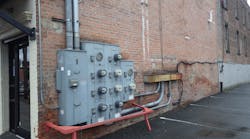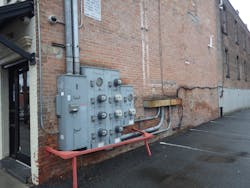Hint: A valiant attempt comes up short.
It was a good effort by the installer to provide some type of protective guards or enclosure for this electrical equipment, since it’s located in a parking lot where cars and trucks could accidentally hit it and cause severe damage. However, I think their efforts came up a little short.
Section 110.27(B) requires electrical equipment installed in locations exposed to physical damage, such as in areas like this, to be protected by guards or enclosures arranged and of enough strength to prevent such damage. There may be better options than simply erecting some strut as protection against damage from vehicles. Steel or concrete pillars, bollards, or curbing would probably be a better option here. In addition, the strut erected around this equipment, is installed too close and violates the working space requirements found in Sec. 110.26(E)(2)(b). Any protective barriers installed must provide the required working space clearances.





